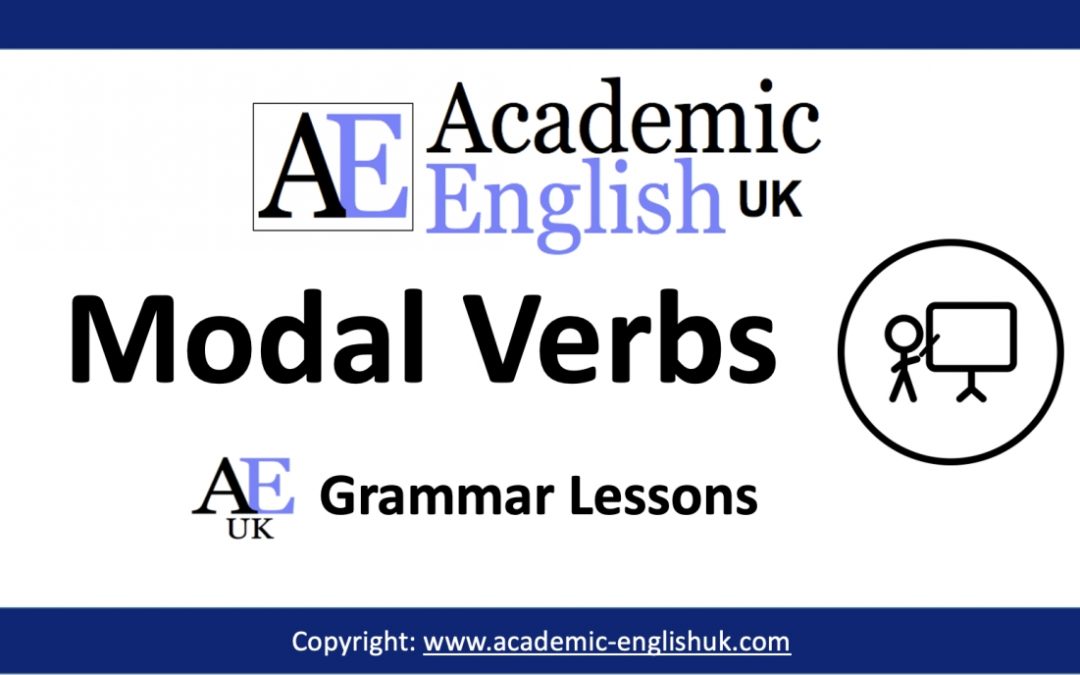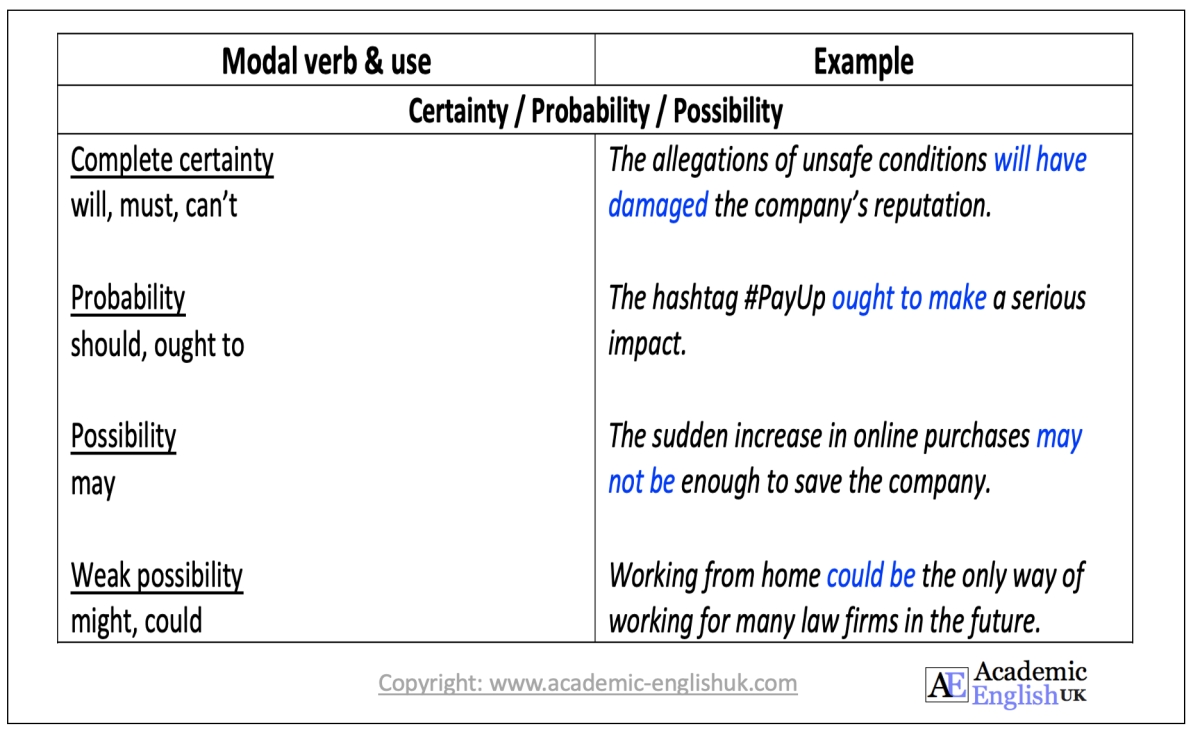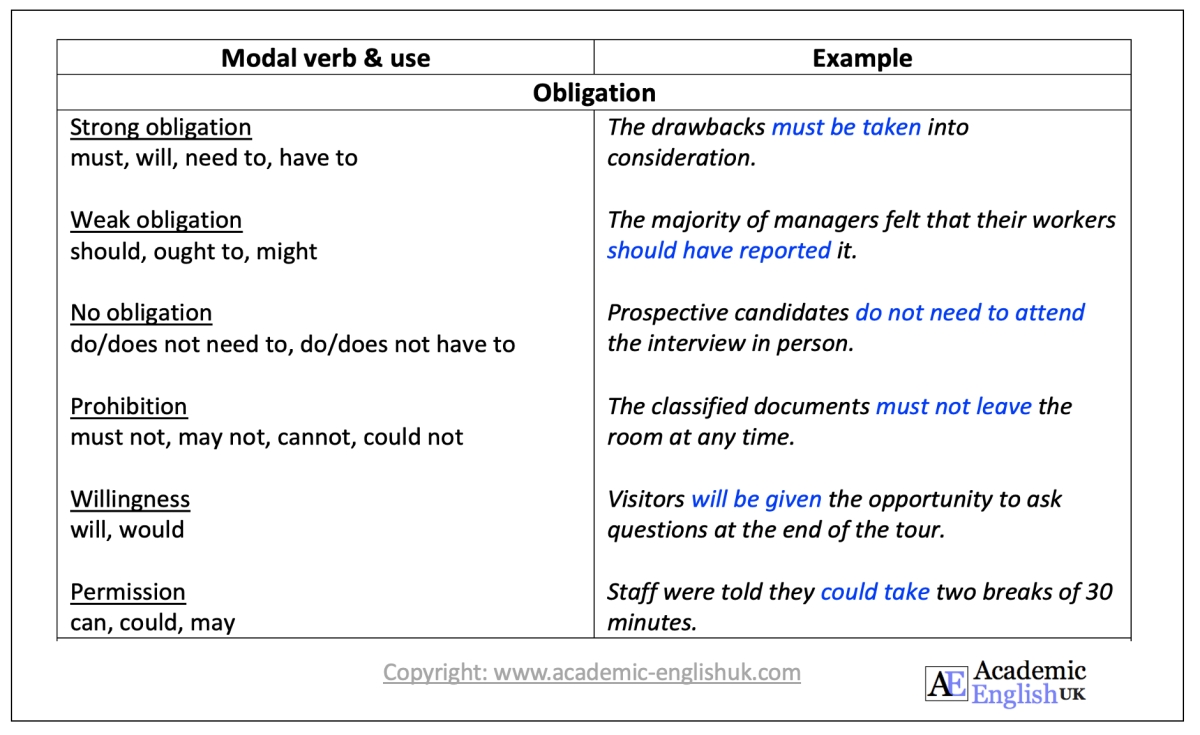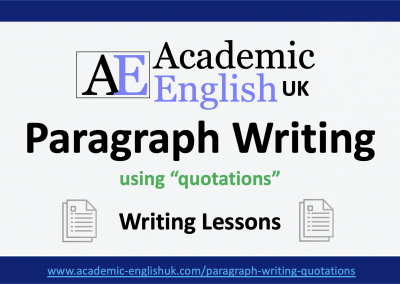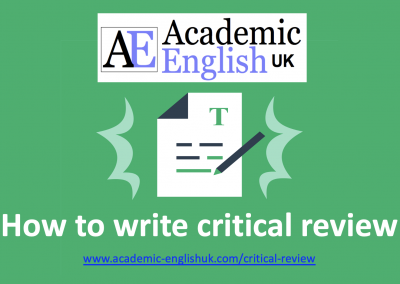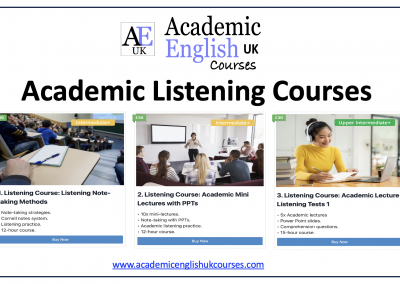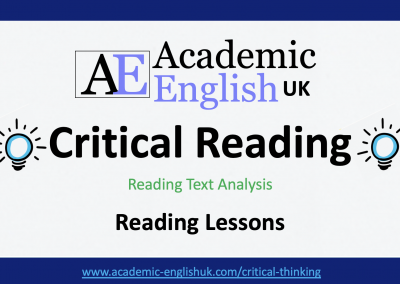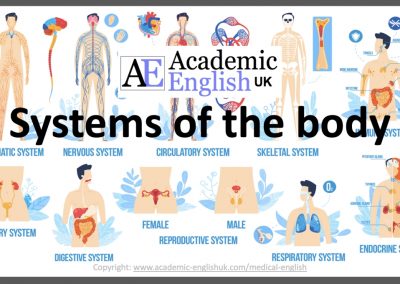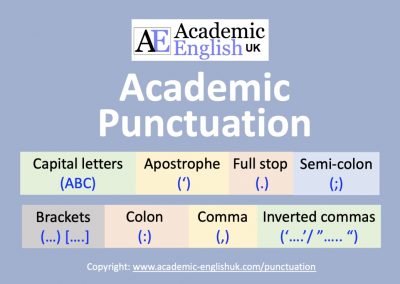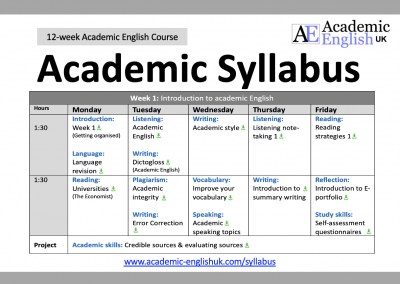What are modal verbs?
Modal verbs are used to express a certain attitude or perspective. They are classified as auxiliary verbs so they have no infinitive form, no gerund form, no past participle and no third person singular form. The negative is formed by adding ‘not’ and the question is made by inverting the subject and modal verb. They can be followed by the infinitive without to, have + past participle and progressive and passive infinitives. Semi modals (have to, need to and be able to) are treated as regular verbs.
Written by Academic English UK
Modal Auxiliary Verbs [new 2021]
This lesson helps improve students’ awareness of modal verbs. It includes a language review section, lots of guided practice and freer paragraph writing practice. (see worksheet example) Time: 60mins. Level ***** [B1/B2/C1] TEACHER MEMBERSHIP / INSTITUTIONAL MEMBERSHIP
Modal Verbs Language Review
Modal Verb Language Exercise
Task 1: Underline the most suitable modal verb in the following sentences.
1. Employees have to/should/could adhere to the strict guidelines at all times.
2. The manager will cannot/not be able to/should not attend the meeting in person.
-
Employees have to adhere to the strict guidelines at all times.
-
The manager will not be able to attend the meeting in person.
For a detailed worksheet and more exercises – buy the Modal verb download below.
Modal Verb Language Exercise
Task 2: Correct the mistakes in the following sentences. Not all are incorrect.
1. Unfortunately for those in the creative industries, they will need to apply for funding.
2. Many people believe that art is one subject that should to be removed from the curriculum.
1. Correct
2. Incorrect – should be removed
For a detailed worksheet and more exercises – buy the Modal verb download below.
Modal Verb Language Exercise
Task 3: Rewrite the following sentences to include the modal verb in brackets.
1. It is possible that the allegations of underpaying workers affected the brand’s overall sales. (may)
The brand’s overall sales ______________________________________________________________________
-
The brand’s overall sales may have been affected by the allegations of underpaying workers.
For a detailed worksheet and more exercises – buy the Modal verb download below.
Modal Verb Language Gap Fill Exercise
Task 4: Read the following paragraph about International Car Free Day and complete the gaps with an appropriate modal verb. Compare with your partner.
Although it ___________ be seen as a gimmick, September 22 is known as World Car Free Day and its aim is to encourage drivers to
give up their cars for one day. Organisers of the event believe it ______________ promote cycling and walking. In fact, ………
Although it may be seen as a gimmick, September 22nd is known as World Car Free Day and its aim is to encourage drivers to give up
their cars for one day. Organisers of the event believe it could promote cycling and walking. In fact,….
For a detailed worksheet and more exercises – buy the Modal verb download below.
Modal Verbs Download
Modal Auxiliary Verbs [new 2021]
This lesson helps improve students’ awareness of modal verbs. It includes a language review section, lots of guided practice and freer paragraph writing practice. (see worksheet example) Time: 60mins. Level ***** [B1/B2/C1] TEACHER MEMBERSHIP / INSTITUTIONAL MEMBERSHIP
Hedging Language
An important feature of academic writing is the concept of cautious language, often called “hedging” or “vague language“. In other words, it is necessary to make decisions about your stance on a particular subject, or the strength of the claims you are making.
Hedging #1: Cautious language exercises
This worksheet is for teachers or students. It provides an overview of hedging / cautious language and 8 exercises to practise using hedging language to demonstrate caution. (see worksheet example) Level ***** [B1/B2/C1]. TEACHER MEMBERSHIP / INSTITUTIONAL MEMBERSHIP
Hedging #2: Cautious / tentative language [new 2020]
This lesson supports students in their understanding & use of cautious / tentative language.The lesson includes six tasks of guided practice & two tasks of freer practice (see worksheet example) Time: 60mins & homework. Level ***** [B1/B2/C1]. TEACHER MEMBERSHIP / INSTITUTIONAL MEMBERSHIP
More grammar and vocabulary downloads...
Causes, Effects & Related Language
This lesson helps improve students' awareness of cause and effect language. It includes a language review section, lots of guided practice and freer paragraph writing practice (see worksheet example) Time: 60mins. Level ***** [B1/B2/C1] / Webpage link. / TEACHER MEMBERSHIP / INSTITUTIONAL MEMBERSHIP
Comparatives & Superlatives
This lesson helps improve students' awareness of compare and contrast language. It includes a language review section, lots of guided practice and freer paragraph writing practice (see worksheet example) Time: 60mins. Level ***** [B1/B2/C1] / Webpage link. / TEACHER MEMBERSHIP / INSTITUTIONAL MEMBERSHIP
Compare & contrast: comparatives and superlatives
This lesson helps improve students' awareness of compare and contrast language. It includes a language review section, lots of guided practice and freer paragraph writing practice (see worksheet example) Time: 60mins. Level ***** [B1/B2/C1]. / TEACHER MEMBERSHIP / INSTITUTIONAL MEMBERSHIP
Academic Conditionals
This lesson helps improve students' awareness of conditionals. It includes a language review section, lots of guided practice and freer paragraph writing practice (see worksheet example) Time: 60mins. Level ***** [B1/B2/C1] TEACHER MEMBERSHIP / INSTITUTIONAL MEMBERSHIP
Countable and uncountable nouns
This lesson helps improve students' awareness of countable & uncountable nouns. It includes a language review section, lots of guided practice and freer paragraph writing practice (see worksheet example) Time: 60mins. Level ***** [B1/B2/C1] TEACHER MEMBERSHIP / INSTITUTIONAL MEMBERSHIP
Modal Auxiliary Verbs
This lesson helps improve students' awareness of modal verbs. It includes a language review section, lots of guided practice and freer paragraph writing practice (see worksheet example) Time: 60mins. Level ***** [B1/B2/C1] TEACHER MEMBERSHIP / INSTITUTIONAL MEMBERSHIP
 Nominalisation (verbs / adjectives to nouns)
Nominalisation (verbs / adjectives to nouns)
An introduction to nominalisation. This worksheet shows the basics of nominalising, practises changing verbs and adjectives to nouns, and includes four exercises from guided practice through to freer practice. Very good writing practice activity with a fair amount of challenge for all levels. Level ***** [B1/B2/C1] (see example sheet) TEACHER MEMBERSHIP / INSTITUTIONAL MEMBERSHIP
*
 Noun Phrases Worksheet 1
Noun Phrases Worksheet 1
This lesson highlights what noun phrases are and provides valuable practice. It focuses on the key concepts of quantifiers, adjectives and nouns, noun + noun, noun + preposition and noun phrase combinations (example). Level ***** [B2/C1] / TEACHER MEMBERSHIP / INSTITUTIONAL MEMBERSHIP
*
 Noun Phrases Worksheet 2
Noun Phrases Worksheet 2
This lesson is designed to help students write more concisely by using noun phrases. It takes students through a whole range of tasks including noticing the language in context, eight guided practice tasks and five freer practice activities. There's a language review sheet included too (see example). Level ***** [B2/C1] TEACHER MEMBERSHIP / INSTITUTIONAL MEMBERSHIP
*
Academic Passive Structures & Nominalisation
An introduction to the impersonal passive structure 'it is said that...' , to infinitive passive form ' it is claimed to be...'. and how to nominalise verbs to nouns to show formality in writing. This worksheet provides key information and 10 writing questions (example). Level ***** [B1/B2/C1] TEACHER MEMBERSHIP / INSTITUTIONAL MEMBERSHIP
*
Relative clauses: defining & non-defining clauses
This lesson is to support students in their understanding and use of defining & non-defining relative clauses.The lesson includes four tasks of guided practice and two tasks of freer practice (see worksheet example) Time: 60mins. Level ***** [B1/B2/C1]. / TEACHER MEMBERSHIP / INSTITUTIONAL MEMBERSHIP
Sentence Structure 1: Simple, compound, complex & complex compound
This lesson is to support students in their understanding and practice of the four types of sentence structures: simple, compound, complex and complex-compound. It includes noticing, guided and freer practice (see worksheet example) Time: 60mins. Level ***** [B1/B2/C1] / TEACHER MEMBERSHIP / INSTITUTIONAL MEMBERSHIP
Sentence Structure 2: Fragment, run-on & comma splice sentences
This lesson helps improve students' sentence structure through identifying and practising fragments, run-ons and comma splice sentences. It includes noticing, guided and freer practice (see worksheet example) Time: 60mins. Level ***** [B1/B2/C1]/ TEACHER MEMBERSHIP / INSTITUTIONAL MEMBERSHIP
Sentence Structure 3: Complex sentence structure (STEM)
This lesson is to support students in their understanding and practice of complex sentence structure. The worksheets focus on three structures: adverbial, adjective and noun clauses and contain key explanations and sentence and paragraph-level practice within a STEM context (see worksheet example) Time: 90mins. Level ***** [B1/B2/C1] TEACHER MEMBERSHIP / INSTITUTIONAL MEMBERSHIP
X
Tense Review (3 lessons: analysis, gap fill, speaking)
This is a great lesson to introduce / revise English Tenses. Lesson 1: students discuss a number of sentences & identify the tense & reason for use. Give out Tense handout (here) to consolidate. Lesson 2: tense review gap fill. Lesson 3: speaking exercise with lots of questions using the tenses. Example Level ***** [B1/B2/C1] TEACHER MEMBERSHIP / INSTITUTIONAL MEMBERSHIP
Verb Patterns
This lesson helps improve students' awareness of verb patterns (verb + infinitive, verb + to infinitive, verb + gerund, verb + that clause, verb + wh-clause) . It includes a language review section, lots of guided practice and freer paragraph writing practice (see worksheet example) Time: 60mins. Level ***** [B1/B2/C1] TEACHER MEMBERSHIP / INSTITUTIONAL MEMBERSHIP

